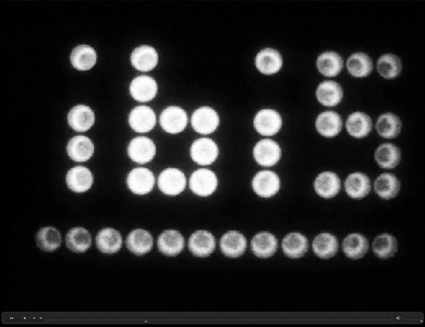Section: Scientific Foundations
Data: High-precision measurements of gene expression in bacteria
Participants : Guillaume Baptist, Sara Berthoumieux, Julien Demol, Johannes Geiselmann [Correspondent] , Jérôme Izard, Hidde de Jong, Stephan Lacour, Yves Markowicz, Corinne Pinel, Stéphane Pinhal, Delphine Ropers, Claire Villiers.
The aim of a model is to describe the functioning of bacterial regulatory networks so as to gain a better understanding of the molecular mechanisms that control cellular responses and to predict the behavior of the system in new situations. In order to achieve these goals, we have to calibrate the model so that it reproduces available experimental data and confront model predictions with the results of new experiments. This presupposes the availability of high-precision measurements of gene expression and other key processes in the cell.
We have resorted to the measurement of fluorescent and luminescent reporter genes, which allow monitoring the expression of a few dozens of regulators in parallel, with the precision and temporal resolution needed for the validation of our models. More specifically, we have constructed transcriptional and translational fusions of key regulatory genes of E. coli to fluorescent and luminescent reporter genes (Figure 4 ). The signals of these reporter genes are measured in vivo by an automated, thermostated microplate reader. This makes it possible to monitor in real time the variation in the expression of a few dozens of genes in response to an external perturbation. We have developed an experimental pipeline that resolves most technical difficulties in the generation of reproducible time-series measurements. The pipeline comes with data analysis software that converts the measurements into representations of the time-course of promoter activities that can be compared with model predictions (Section 5.2 ). In order to obtain rich information about the network dynamics, we have begun to measure the expression dynamics in both wild-type and mutant cells, using an existing E. coli mutant collection. Moreover, we have developed tools for the perturbation of the system, such as expression vectors for the controlled induction of particular genes.
|
While reporter gene systems allow the dynamics of gene expression to be measured with high precision and temporal resolution on the level of cell populations, they do not provide information on all variables of interest though. Additional technologies may complement those that we have developed in our laboratory, such as mass-spectrometry tools in proteomics and metabolomics that are able to quantify the amounts of proteins and metabolites, respectively, in the cells at a given time-point. In addition, for many purposes it is also important to be able to characterize gene expression on the level of single cells instead of cell populations. This requires experimental platforms that measure the expression of reporter genes in isolated cells by means of fluorescence and luminescence microscopy. IBIS has access to these technologies through collaborations with other groups on the local and national level, such as the INSA de Toulouse and the Laboratoire de Spectrométrie Physique at the Université Joseph Fourier.



